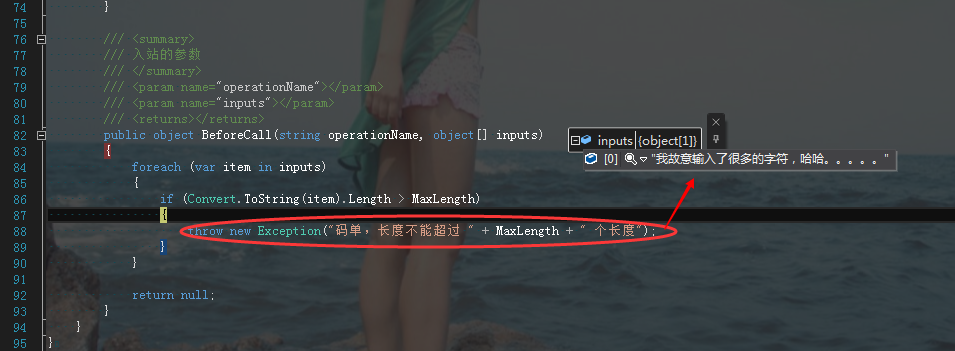终于我又看完了二期爱情保卫战,太酸爽了,推荐链接:http://www.iqiyi.com/a_19rrgublqh.html?vfm=2008_aldbd,不多说,谁看谁入迷,下面言归正传,
看看这个很有意思的Behavior。
一: Behavior这个泼妇的厉害
在前面的文章中,我也清楚的说明了整个wcf通信流,而Behavior这个泼妇可以在wcf通信流中的任何地方插上一脚,蛮狠无比,利用的好,让你上天堂,利用的不
好,让你下地狱。。。下面让你看看behavior到底有哪些可以注入的点???先画个简图:
上面的图,大概就是wcf的通信简图,所有蓝色字体都是Behavior注入的点,其中Client和Service端都可以注入,如果按照功能分的话,又可以分为“操作级别”和
”端点级别“,下面我来简要的分解下。
二:端点级别Behavior
从图中你也可以看到,消息检查器是放在Channel这个级别的,也就是说它可以监视Client和Server的入站请求,也就是说所有的请求都需要通过它转发,如果
这样的话,那我是不是可以在这个注入点上自由的修改,变更,拦截入站和出站请求,而且利用这个特性我还可以做很多的事情,比如日志记录,记录统计等等,下
面我们来看看这个怎么使用??? 只需要extends IEndpointBehavior 和 IDispatchMessageInspector,然后加入EndpointBehaviors即可。。。
1. IDispatchMessageInspector
1 public class MyDispatchMessageInspector : IDispatchMessageInspector 2 { 3 public object AfterReceiveRequest(ref Message request, IClientChannel channel, InstanceContext instanceContext) 4 { 5 Console.WriteLine(request.ToString()); 6 return request; 7 } 8 9 public void BeforeSendReply(ref Message reply, object correlationState) 10 { 11 Console.WriteLine(reply.ToString()); 12 } 13 }
2. IEndpointBehavior
1 public class MyEndpointBehavior : IEndpointBehavior 2 { 3 public void AddBindingParameters(ServiceEndpoint endpoint, BindingParameterCollection bindingParameters) 4 { 5 } 6 7 public void ApplyClientBehavior(ServiceEndpoint endpoint, System.ServiceModel.Dispatcher.ClientRuntime clientRuntime) 8 { 9 } 10 11 public void ApplyDispatchBehavior(ServiceEndpoint endpoint, System.ServiceModel.Dispatcher.EndpointDispatcher endpointDispatcher) 12 { 13 endpointDispatcher.DispatchRuntime.MessageInspectors.Add(new MyDispatchMessageInspector()); 14 } 15 16 public void Validate(ServiceEndpoint endpoint) 17 { 18 } 19 }
3. 将MyEndpointBehavior加入到Host中
1 static void Main(string[] args) 2 { 3 ServiceHost host = new ServiceHost(typeof(HomeService), new Uri("http://127.0.0.1:1920")); 4 5 host.AddServiceEndpoint(typeof(IHomeService), new BasicHttpBinding(), "HomeServie"); 6 7 host.Description.Behaviors.Add(new ServiceMetadataBehavior() { HttpGetEnabled = true }); 8 9 host.AddServiceEndpoint(typeof(IMetadataExchange), MetadataExchangeBindings.CreateMexHttpBinding(), "mex"); 10 11 host.Description.Endpoints[0].EndpointBehaviors.Add(new MyEndpointBehavior()); 12 13 host.Open(); 14 15 Console.WriteLine("服务已经开启!!!"); 16 17 Console.Read(); 18 }
4. 最后我们看一下服务方法
1 public class HomeService : IHomeService 2 { 3 public string Update(string message) 4 { 5 Console.WriteLine("我在Action方法:" + message); 6 7 return "my reply!!!"; 8 } 9 }
下面看看效果。。。在效果图中,你应该看到了。在我的Action中的方法前后各有一段“入站消息”和“出站消息”,是不是很爽???

三:操作级别Behavior
从文章开头的简图中,你应该看到了,Operation级别的Behavior比较多,有“操作启动器(IOperationInvoker)","参数检查(IParameterInspector)“,
“消息格式化器(IDispatchMessageFormatter)”等等。。。 为什么说等等这个词,很简单啊,,,其实还有很多系统内置的,既然是Operation,那就必
然是针对方法的,还记得OperationContract是怎么套在方法上的吗??? 是特性,对吧,,,同样的道理,OperationBehavior也是一样,那怎么用呢??
同样也是很简单的,继承几个接口即可。。。
<1> IParameterInspector 的玩法
其实没什么好说的,既然是属于Operation下面的Behavior,那都是通过特性注入的,而这个IParameterInspector,可以做到类似Mvc的Model验证,下面
我做个简单的Action参数长度验证(长度不超过8个字符)。
1. IParameterInspector
1 public class MyIParameterInspector : IParameterInspector 2 { 3 public int MaxLength { get; set; } 4 5 public MyIParameterInspector(int MaxLength) 6 { 7 this.MaxLength = MaxLength; 8 } 9 10 /// <summary> 11 /// 出站的操作 12 /// </summary> 13 /// <param name="operationName"></param> 14 /// <param name="outputs"></param> 15 /// <param name="returnValue"></param> 16 /// <param name="correlationState"></param> 17 public void AfterCall(string operationName, object[] outputs, object returnValue, object correlationState) 18 { 19 20 } 21 22 /// <summary> 23 /// 入站的参数 24 /// </summary> 25 /// <param name="operationName"></param> 26 /// <param name="inputs"></param> 27 /// <returns></returns> 28 public object BeforeCall(string operationName, object[] inputs) 29 { 30 foreach (var item in inputs) 31 { 32 if (Convert.ToString(item).Length > MaxLength) 33 { 34 throw new Exception("码单,长度不能超过 " + MaxLength + " 个长度"); 35 } 36 } 37 38 return null; 39 } 40 }
2. IOperationBehavior
1 public class MyOperationBehavior : Attribute, IOperationBehavior 2 { 3 public int MaxLength { get; set; } 4 5 public void AddBindingParameters(OperationDescription operationDescription, BindingParameterCollection bindingParameters) 6 { 7 8 } 9 10 public void ApplyClientBehavior(OperationDescription operationDescription, ClientOperation clientOperation) 11 { 12 13 } 14 15 public void ApplyDispatchBehavior(OperationDescription operationDescription, DispatchOperation dispatchOperation) 16 { 17 dispatchOperation.ParameterInspectors.Add(new MyIParameterInspector(MaxLength)); 18 } 19 20 public void Validate(OperationDescription operationDescription) 21 { 22 23 } 24 }
3. 在Action在加上MyOperationBehavior 这个 Attribute
1 public class HomeService : IHomeService 2 { 3 [MyOperationBehavior(MaxLength = 5)] 4 public string Update(string message) 5 { 6 Console.WriteLine("我在Action方法:" + message); 7 8 return "my reply!!!"; 9 } 10 }
4. 然后我在客户端故意输入大于5的字符,看看效果怎么样???
1 public class Program1 2 { 3 static void Main(string[] args) 4 { 5 HomeServiceClient client = new HomeServiceClient(); 6 7 client.Update("我故意输入了很多的字符,哈哈。。。。。"); 8 9 Console.Read(); 10 } 11 }
5. 最后看看效果图,可以看到,最终的入站消息会抛出一个异常。。。

<2> MessageFormatter,IOperationInvoker 的玩法
剩下的这两个玩法都差不多,你只需要extends一下,然后加入到OperationBehavior即可,有了上面的思想,我想下面这些使用起来都不是问题吧。。。
